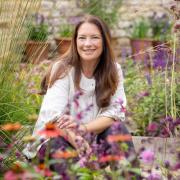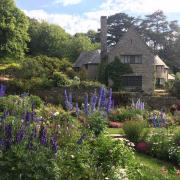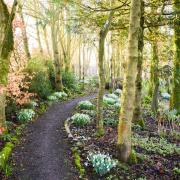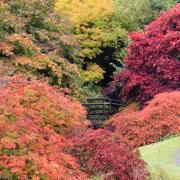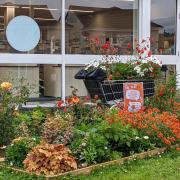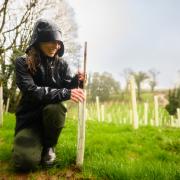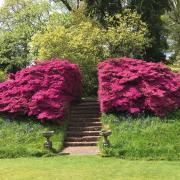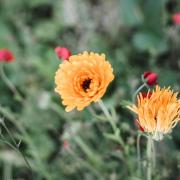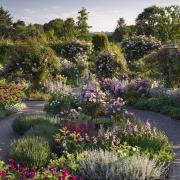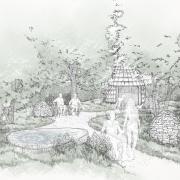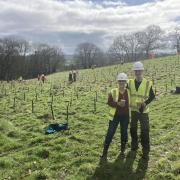In spring and summer gardens abound with floral offerings. Come October, and it's the turn of the foliage. Why does it happen, and where can you best see it? Terry Underhill explains, and flags up some of the gardens in the county where you can be...
Why does autumn colour happen? It's a bit of a mix really - some basic chemistry combined with the effect of the weather. For the spring and summer months, leaves are (mainly) green because of chlorophyll, the chemical responsible for trapping the sun's energy. This masks other colours. As we move into October, cooler night temperatures slow down plant growth, they stop making chlorophyll (or the chill even destroys it) and the other plant pigments lurking within the cells are revealed in all the glorious colours of autumn.
Earlier in the year these coloured chemicals can sometimes be seen when a blanched shoot is exposed to the light. Red, orange and purple hues appear, quickly disappearing as the chlorophyll develops and the green colour takes over.
The dying-off of chlorophyll is not the whole colour story. Whenever the sun shines and the temperature is high enough, plants will manufacture energy-storing sugars. To avoid pickling themselves, they convert these to starches or oils, use them for tissue growth or for manufacturing other substances, many of which are coloured - purples, reds, oranges and yellows. The waste products of all this activity are usually brown, and these are stored in the leaves to be disposed off when the leaves fall.
Weather conditions play a significant part. The best colours develop when we have an early autumn with dry, bright, sunny days and cool nights, which allow red pigments to develop. If it's cloudy and warm the chlorophyll breaks down only slowly and the red pigments don't form so quickly. If it's wet and windy, the leaves fall prematurely, while fierce frosts stop the whole colouration process altogether.
Think of a painter's palette and the various combinations of these coloured chemicals and you have the colours of autumn leaves. Reds and yellows combine to form oranges, but yellows and purples make browns, and, if mixed with too much waste material, the leaves are just shades of a miserable sludge colour.
Some plants are more reliable than others for autumn leaf colour. The best known are the maples (Acers), but deciduous spindles, berberis, cotoneaster and azaleas, dogwoods (Cornus) and iron wood (Parrotia) are also popular.
Many trees produce outstanding autumn leaf colour. These include the cherries (Prunus), rowan (Sorbus), American sweet gum (Liquidambar) and Cercidiphyllum. The fallen leaves of the latter have an extra twist in that they smell like burnt sugar.
Some years are better than others for autumn colour; some gardens are more suitable, especially those with moisture-retentive loams rather than quick-drying sandy soils. Domestic gardens can produce wonderful surprises. Get the right weather and timing, and the colour of beech, oak and larch, along with elder, spindle and viburnum, can almost rival the maples of New England in the fall.
Devon is fortunate in having many public gardens with a wide plant range. The following are just some of the places where you can see this annual colour extravaganza, although when and where depends very much on the weather.
Opening dates and times are very variable. The National Gardens Scheme 'Yellow Book' has full details, or visit: www.ngs.org.uk.
Gardens open all year
Bicton College, East Budleigh
Amongst the wide range of plants here are many that display autumn colour. The gardens are also used for teaching purposes, (tel 01395 562353.) Bicton Gardens, next door to Bicton College, have extensive grounds and a historic arboretum.
Dartington Hall Gardens, near Totnes
This lovely 25-acre garden, developed by Dorothy and Leonard Elmhirst, incorporates numerous trees and shrubs that are particularly fine in autumn. (Tel 01803 862367.)
Killerton, Broadclyst
A historic National Trust garden, where the colourful foliage of deciduous trees and shrubs harmonises with mature evergreens. (Tel 01392 881345.)
Knightshayes, near Tiverton
This National Trust garden covering 50 acres is known as 'The Garden in the Wood', and provides the perfect conditions for autumn foliage colour. (Tel 01884 254665.)
Marwood Hill Garden, Marwood
This large and inspirational garden north of Barnstaple was created under the leadership of the late Dr Jimmy Smart. Autumn splashes of foliage colour on the hillsides are reflected in the lakes in the valley bottom. (Tel 01271 342528.)
Mount Edgcumbe Garden and Country Park, Cremyll, Torpoint
Although just over the border in Cornwall (cross on the Cremyll Ferry), the 865 acres of garden and parkland on Rame Head are actually under the jurisdiction of both Cornwall County and Plymouth City Councils. Not only is there wonderful autumn colour, there are also spectacular views.
RHS Garden Rosemoor, Torrington
Here, understandably, is the widest range of plants in the county cultivated and displayed to perfection, at all times of the year. (Tel 01805 624067.)
Gardens open by appointment
Hamblyn's Combe, Bridget McCrum's sculpture garden at Dittisham: (Tel 01803 722228.)
Heathercombe, Manaton: (Tel 01647 221222.)
Sherwood, Newton St Cyres: 15-acre woodland garden open every Sunday afternoon throughout the year, and also by appointment. (Tel 01392 851216.)
Wood Barton, Kentisbeare: (Tel 01884 266285.)
Gardens closing in late autumn
Andrew's Corner, Belstone, near Okehampton
This garden remains open under the National Gardens Scheme until 21 October, so that visitors can enjoy the autumnal display. (Tel 01837 840332.)
The Garden House, Buckland Monachorum
More than 6,000 plant varieties make this garden colourful at all times of the year. Open until 4 November, then weekends until 16 December. Also open for snowdrop walks and other special events: www.thegardenhouse.org.uk.
(Tel 01822 854769.)
Gorwell House, Barnstaple
Four acres overlooking the Taw Estuary, with a benign climate allowing many rare and tender plants to flourish among a wide range of hardier trees and shrubs. Open until 7 October.
Lukesland, near Ivybridge
24 acres of woodland garden open during the last two weeks of October and early November for autumn foliage displays. (Tel 01752 691749.)



